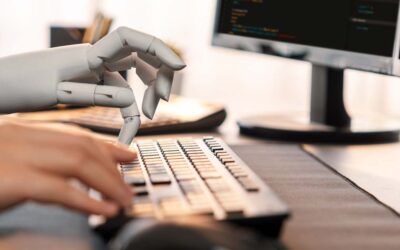Intellectual Property and AI
Lauren Hays
One way I have found AI helpful in my own work is by having it create logos or images that I use when advertising an event, resource, or service.
Specifically, I used the image creation tool in Canva to design an image used to advertise a professional development workshop. This saved me a great deal of time, and was better than anything I could have created on my own.
When talking to others about AI, I have often shared this example and similar ones. Recently, though, I started thinking about trademark law in my use of AI. My work and use of AI has never been something that needs a trademark—if I had not created an image with AI, I likely would have used an image with a Creative Commons license. That said, as I speak with others about AI, it is increasingly important to bring up trademark law, just as I have done with copyright (you can read more about copyright and AI here).
I am not a lawyer and am not qualified to give legal advice, but I want to share resources with you that will help you think about intellectual property broadly with your use, and support, of AI.
United States Patent and Trademark Office AI Resources
United States Patent and Trademark Office Latest AI News
World Intellectual Property Organization (WIPO) AI Resources
I hope you find these resources helpful, and I hope they spark additional research.
These resources highlight that just as with copyright law, images created by AI cannot be trademarked. The same intellectual property laws that apply to work created by humans are not applicable to AI-generated content. Therefore, it is important for individuals to think critically about when an AI-generated image is sufficient, and when humans should create images.
Additionally, you may need to have conversations with the legal team at your place of employment to decide how and when to use AI-generated work in advertisements or promotional material.
Somewhat related, I also want you to be aware that there are repositories of AI-generated images you can use—similar to sites with Creative Commons images or stock libraries. Two such repositories are Impossible Images and AI Scribbles.
Lauren Hays
Dr. Lauren Hays is an Assistant Professor of Instructional Technology at the University of Central Missouri, and a frequent presenter and interviewer on topics related to libraries and librarianship. Please read Lauren’s other posts relevant to special librarians. Learn about Lucidea’s powerful integrated library systems, SydneyDigital, and GeniePlus, used daily by innovative special librarians in libraries of all types, sizes and budgets.
**Disclaimer: Any in-line promotional text does not imply Lucidea product endorsement by the author of this post.
Never miss another post. Subscribe today!
Similar Posts
Growing Your Leadership Skills: 7 Tips for Special Librarians
Great library leaders aren’t born—they’re made through learning self-reflection and practice. Here are seven strategies to help you grow and lead with impact.
Keeping Up with Copyright and Generative AI: What Special Librarians Need to Know
As generative AI becomes more prevalent copyright law is evolving to address its impact. A new report from the U.S. Copyright Office provides guidance on what is (and isn’t) copyrightable.
Understanding Shadow AI: Risks Costs and Governance
AI can enhance search discovery and efficiency but unsanctioned adoption—known as “shadow AI”—can lead to budget overruns and compliance risks. Here’s how to evaluate AI pricing models and build a governance strategy that balances innovation with cost control.
Interview with an Author: Fernandez on Streaming Video Collection Development
As demand for streaming video in libraries grows so do the challenges of managing access budgets and licensing. Co-author Michael Fernandez shares key insights from his book “Streaming Video Collection Development and Management”.







Leave a Comment
Comments are reviewed and must adhere to our comments policy.
0 Comments